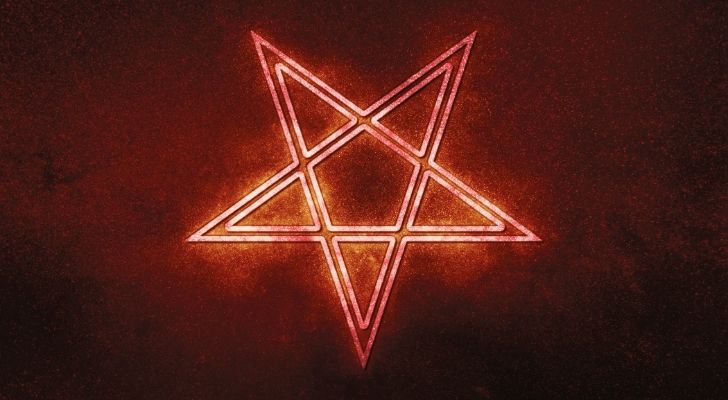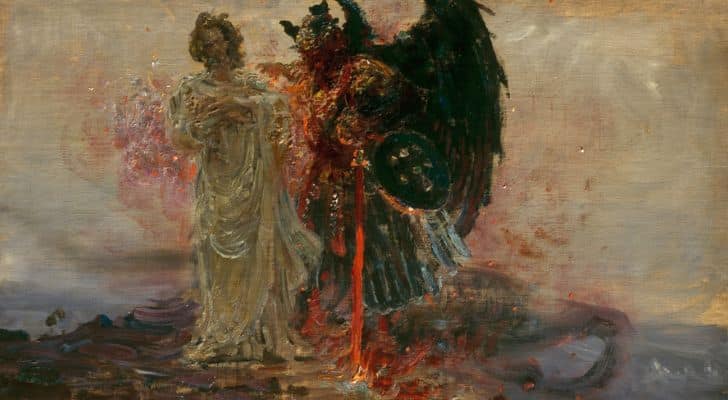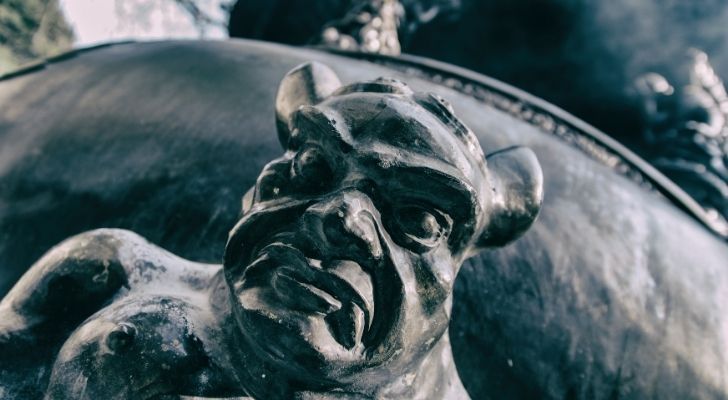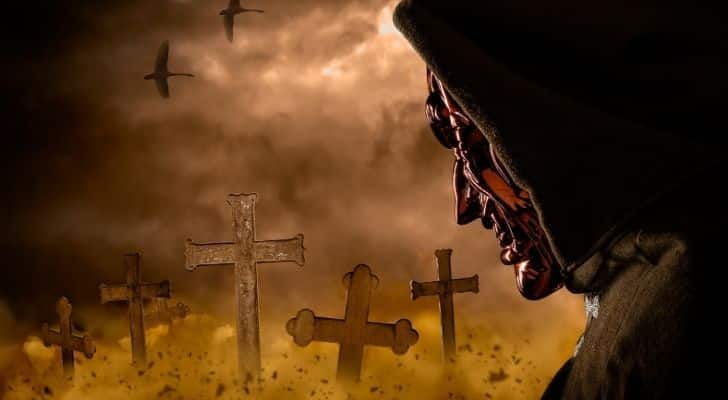Satan, also known to many as the devil, is known as the representation of evil in the world.
For thousands of years, this character has been written about across various religious texts as the enemy of God.
But does Satan represent a person, or is he just a fictional character? And how did he end up in hell?
Here are 10 sinister facts about Satan that you should know.
The word Satan means adversary.

The name Satan can be translated from many different languages to mean different things, but they all link back to what we think of when we hear the word, Satan.
The word “Satan” in Hebrew is a generic noun that means “accuser” or “adversary.”
In the Hebrew Bible, this word is used for human and supernatural adversaries.
It is said to have derived from the verb that would have been used for “obstruct.”
This is how Satan’s name came to be the most commonly used word to describe the opponent of God.
Satan first appeared in a poem called Paradise Lost.

The idea of a character representing evil first appeared in the text Paradise Lost.
Up until this point, Satan had no set representation or form that had been established.
Written in 1677, John Milton’s poem explains the fall of man and the fall of an angel.
Milton’s poem bases Satan on the idea of him being a foe of man and God with Medieval ideas of what Satan represented.
This was one of the first texts to help clarify and define what Satan was.
Satan wasn’t always a character to be fearful of.

In the Middle Ages, Satan was seen as a laughing stock and a character that was more of an annoyance to God.
Satan would often be depicted in theatrical plays as the comedic fool, who was not only clumsy but an ugly character too.
American historian Jeffrey Burton Russell described Satan as “more pathetic and repulsive than terrifying” during the Middle Ages.
A collection of writings called “The Golden Legend” was compiled around 1260, and they told tales of saint’s encounters with Satan.
They spoke of how the saints would use their intelligence to overcome him.
It wasn’t until the 1430s that Satan became associated with witchcraft, and this is when he started to become seen as a fearful character.
Satan’s number is 666.

The number 666 is known as “the number of the beast” or that of Satan or any demon.
It was first written in chapter 13 of the Book of Revelation of the New Testament.
Number 666 is associated with being “man’s number” or “the number of a man.”
In the Book of Revelation, 666 was the number given to Roman Emperor Nero, as it is the numeric value of his name.
He was a nasty and vicious ruler; therefore, this is where the association of the number 666 and evil has stemmed from.
In mathematics, 666 is a triangular number and has many properties that make it appear magical.
Some people take the number association so seriously that they avoid all connections with 666 as they fear it is the devil’s work.
Satan is one of the seven Princes of Hell.

In 1409, John Wycliffe comprised a list of the seven fallen angels who were all tempted by sin.
Each of the princes fell from heaven for evil sins alongside Lucifer in the battle against Michael.
Lucifer fell because of Pride, and he is seen as the worst due to his status in heaven.
Beelzebub fell due to envy; Satan was from wrath, Abadon from sloth, Mammon from greed, Belphegor from gluttony, and Asmodeus from lust.
Although each sin was labeled with an angel, all the sins form what we know as Satan.
Satan is sometimes used as the summary name for all seven sins.
Wrath is seen as one of the most powerful sins hence why Satan has become one of the most common names for evil.
Satan has an entourage of demons.

Satan isn’t alone in hell. He has his crowd of equally evil and sinful characters.
The most common form of servant associated with Satan is a demon.
These are summoned by Satan and are usually in the form of an evil spirit.
Satan obtains these spirits from the deceased who committed sins on earth, or alternatively, they are other fallen angels that sided with Lucifer.
Demons are set to carry out all of Satan’s desires on earth, whether it be terrorizing humans or tempting them into sinful acts.
The word demon comes from the Greek word of “daimon,” which links to the words spirit and guide.
Essentially a demon is both of these; however, demons will guide you towards evil rather than good.
Satan is heavily linked to witches and witchcraft.

Witchcraft, fairies, and magic have been believed in for thousands of years, but it was until the 15th Century that some aspects became associated with Satan.
Until this point, the unknown and mystical elements of life were seen as normal representations of both good and evil acts.
In the 15th Century, the concept of organized satanic witchcraft started to become a common take on magic.
Across Europe, from the 13th Century, Christian churches began to label witchcraft as being an act of evil and that witches were the servants of Satan.
At the time, people were becoming more educated and sophisticated and, therefore, could understand ancient religious texts in more detail.
This meant that texts about the devils’ work in summoning humans and tempting humans become more real and applied to daily situations.
The Christian church was against witchcraft, and therefore in order to banish and prosecute witches, these links to Satan gave them a valid reason.
This was when Satan became seen as an active enemy rather than an adversary to God.
Satan was once an angel named Lucifer.

In Christianity, the devil is known most commonly as a fallen angel. In Islam, though, he’s depicted as a jinn (genie).
The story in Christianity is that Lucifer went against God and was banished from heaven.
Some variations tell that he put himself forward to be the figure of the suffering of humanity, and when Jesus was chosen, Lucifer let his pride overcome him.
Lucifer was a powerful angel with good looks and intelligence, and it was this that gave him pride.
His pride become overpowering and led to his exile and banishment from heaven.
Like other angels, he had a choice, and he let his sins overpower him and go against God’s will.
Lucifer never lost his powers or intelligence and is known for leading the opposition to God.
God never intended to create evil, and with Lucifer’s fall, he was always seen as God’s adversary.
More Americans believe in Satan than in Darwin.

Statistics show that more Americans believe in the existence of Hell and Satan than in Darwin’s theory of evolution.
The Harris poll surveyed 2,455 American citizens in 2005 with questions regarding belief.
The survey showed that 82% believed in God, 79% believed in miracles, and 62% believed in Satan and hell.
The audience that was skeptical of Darwin’s theory of evolution revealed that only 42% believed in his science.
This indicates that there is more belief in Satan than in the theory of evolution.
Statistics have also shown an increase in the number of people believing in Satan.
A poll from 1990 showed that 55% of Americans believe in the devil and that there is a hell.
Gallup Poll showed that this rose to 70% of Americans in 2007.
This is most likely due to the high numbers of religiously active people in the USA.
Satan’s physical appearance is ever-evolving.

Satan, or the devil, is represented in many varying forms across cultures.
Some believe that he is a force like God but is the force of all evil.
In the Bible, he is believed to have been the snake that tempted Adam and Eve, and he has been known to take varying representational forms.
A mosaic found in the Basilica of Sant’Apollinare Nuovo, Ravenna, Italy, shows one of the first Christian representations of Satan.
This piece of art from the 6th Century shows Jesus Christ with what is assumed to be representations of good and evil by his side.
It was only in more recent years that he has become associated with his devilish form.
One of Satan’s first representations is from the Middle Ages, and he is represented as a horned goat.
His form represented elements that we associated with evil, horror, and decay.
However, this personification has developed and been shaped by our conceptions of what we consider to be evil.
By the 18th and 19th centuries, his persona had become romanticized and more human-like, perhaps resembling some of the evil seen throughout the ages.
Satan is the adversary to God, and this keeps the world balanced with good and evil.
Without Satan, the world would have no evil and suffering, but Satan is a reminder that evil still exists.
Although Satan was first seen as an annoyance and harmless character, his persona has developed through the ages to become something we fear.
Some people find contentment in Satan’s story and journey as they can relate to similar suffering; however, it is not a reason to implement suffering on others.


















